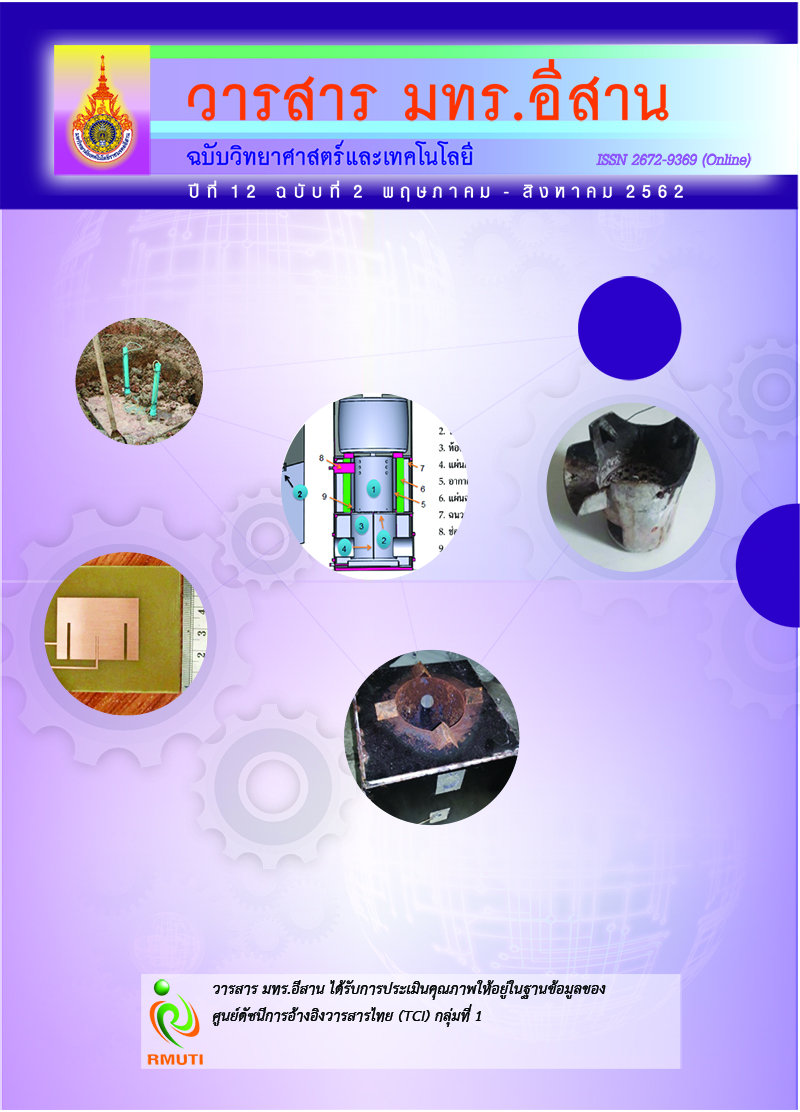สารประกอบบิวทิลทินในหอยแมลงภู่ชนิด Perna viridis บริเวณชายฝั่งทะเล จังหวัดชลบุรี ระยอง และตราด
Main Article Content
บทคัดย่อ
สารประกอบบิวทิลทินเป็นสารที่มีการปนเปื้อนในสิ่งแวดล้อมบริเวณชายฝั่งทะเลเนื่องจากการใช้สีทาเรือ ที่มีสารไตรบิวทิลทิน เป็นส่วนผสมสารกลุ่มนี้สามารถหลุดออกจากเรือสะสมในสิ่งแวดล้อม และมีผลกระทบต่อสิ่งมีชีวิตในระบบนิเวศทางทะเล ภายหลังองค์การทางทะเลระหว่างประเทศจึงประกาศยกเลิกการใช้สารกลุ่มนี้ ในสีทาเรือตั้งแต่ปี ค.ศ. 2008 เป็นต้นมา แต่เนื่องจากสารกลุ่มนี้มีการสะสมยาวนานจึงควรมีการตรวจวัด ปริมาณอย่างต่อเนื่อง สำหรับประเทศไทยพบรายการการปนเปื้อนของสารประกอบบิวทิลทินในสัตว์เป็นครั้งแรก ในหอยแมลงภู่ชนิด Perna viridis บริเวณชายฝั่งทะเล ในปี ค.ศ. 1994 และ 1995 โดยพบสารประกอบบิวทิลทินในหอยแมลงภู่บริเวณชายฝั่งทะเลประเทศไทยปริมาณเฉลี่ย 49 ng/g ของนํ้าหนักสด โดยใน จังหวัดชลบุรี ระยอง และตราด มีปริมาณเฉลี่ย 32 73 และ 16 ng/g ของนํ้าหนักสด ตามลำดับ และ ในปี ค.ศ. 2004 มีการตรวจวัดในหอยแมลงภู่ชนิดนี้อีกครั้ง บริเวณชายฝั่งทะเลอ่าวไทยตอนบน พบสารประกอบบิวทิลทินปริมาณเฉลี่ย 35 ng/g ของน้ำหนักสด โดยในภาคตะวันออกพบรายงานในจังหวัดชลบุรีมีปริมาณเฉลี่ย 70 ng/g ของน้ำหนักสด อย่างไรก็ตามภายหลังการยกเลิกการใช้สารกลุ่มนี้ในสีทาเรือในปี ค.ศ. 2008 ยังไม่พบรายงานการปนเปื้อนของสารกลุ่มนี้ในหอยแมลงภู่อีก การศึกษาครั้งนี้จึงมีวัตถุประสงค์เพื่อตรวจวัดปริมาณสารประกอบบิวทิลทินในหอยแมลงภู่ชนิด Perna viridis บริเวณชายฝั่งทะเลจังหวัดชลบุรี ระยอง และตราด โดยใช้สาร Sodium tetraethylborate ในการสร้างอนุพันธ์ของสารประกอบทิน และวิเคราะห์ด้วยเทคนิค GC-MS ผลการศึกษาพบว่าสามารถตรวจพบสารประกอบบิวทิลทินในเนื้อเยื่อหอยแมลงภู่ มีปริมาณเฉลี่ย 2.66 ng/g ของน้ำหนักแห้งคิดเป็น 0.49 ng/g ของน้ำหนักสด โดยแบ่งเป็นจังหวัดชลบุรี ระยอง และตราด มีค่าเฉลี่ย 1.04 5.98 และ 0.95 ng/g ของน้ำหนักแห้งตามลำดับ ซึ่งคิดเป็น 0.23 1.10 และ 0.15 ng/g ของนํ้าหนักสด ตามลำดับ ข้อมูลจากการศึกษาในครั้งนี้แสดงให้เห็นว่าการสะสมของสารประกอบบิวทิลทินในเนื้อเยื่อหอยแมลงภู่มีแนมโน้มลดลงอย่างมากเมื่อเทียบกับปริมาณที่พบในอดีต
Article Details
เอกสารอ้างอิง
[2] Bryan, G. W., Gibbs, P. E., Hummerstone, L. G., and Burt, G. R. (1986). The Decline of the Gastropod Nucella lapillus Around South West England: Evidence for the Effect of Tributyltin From Antifouling Paints. Journal of the Marine Biological Association of the United Kingdom. Vol. 66, Issue 3, pp. 611-640. DOI: 10.1017/S0025315400042247
[3] Alzieu, C. L., Sanjuan, J., Deltreil, J. P., and Borel, M. (1986). Tin Contamination in Arcachon Bay: Effects on Oyster Shell Anomalies. Marine Pollution Bulletin. Vol. 17, Issue 11, pp. 494-498. DOI: 10.1016/0025-326X(86)90636-3
[4] Antizar-Ladislao, B. (2008). Environmental Levels, Toxicity and Human Exposure to Tributyltin (TBT)-Contaminated Marine Environment. Environment International. Vol. 34, Issue 2,
pp. 292-308. DOI: 10.1016/j.envint.2007.09.005
[5] Sidharthan, M., Young, K. S., Woul, L. H., Soon, P. K., and Shin, H. W. (2002). TBT Toxicity on the Marine Microalga Nannochloropsis oculata. Marine Pollution Bulletin. Vol. 45, Issue 1-12, pp. 177-180. DOI: 10.1016/S0025-326X(01)00283-1
[6] Jensen, H. F., Holmer, M., and Dahllof, I. (2004). Effects of Tributyltin (TBT) on the Seagrass Ruppia maritima. Marine Pollution Bulletin. Vol. 49, Issue 7-8, pp. 564-573. DOI: 10.1016/j.marpolbul.2004.03.010
[7] Oehlmann, J., Stroben, E., Schulte-Oehlmann, U., and Bauer, B. (1998). Imposex Development in Response to TBT Pollution in Hinia incrassata (Strm, 1768) (Prosobranchia, Stenoglossa). Aquatic Toxicology. Vol. 43, No. 4, pp. 239-260. DOI: 10.1016/S0166-445X(98)00058-7
[8] Horiguchi, T., Kojima, M., Hamada, F., Kajikawa, A., Shiraishi, H., Morita, M., and Shimizu, M. (2006). Impact of Tributyltin and Triphenyltin on Ivory Shell (Babylonia japonica) Populations. Environmental Health Perspectives. Vol. 114, Supplement 1, pp. 13-19. DOI: 10.1289/ehp.8047
[9] Ohji, M., Arai, and T., Miyazaki, N. (2005). Acute Toxicity of Tributyltin to the Caprellidea (Crustacea: Amphipoda). Marine Environmental Research. Vol. 59, Issue 3, pp. 197-201. DOI: 10.1016/j.marenvres.2004.02.002
[10] Zhang, J., Zuo, Z., Chen, Y., Zhao, Y., Hu, S., and Wang, C. (2007). Effect of Tributyltin on the Development of Ovary in Female Cuvier (Sebastiscus marmoratus). Aquatic Toxicology. Vol. 83, Issue 3, pp. 174-179. DOI: 10.1016/j.aquatox.2007.03.018
[11] International Maritime Organization (IMO). (2001). International Convention on the Control of Harmful Anti-Fouling Systems on Ships. Access (August, 2018). Available (http://www.imo.org/en/About/Conventions/ListOfConventions/Pages/International-Convention-on-the-Control-of-Harmful-Anti-fouling-Systems-on-Ships-(AFS).aspx)
[12] Cole, R. F., Mills, G. A., Parker, R., Bolam, T., Birchenough, A., Kröger, S., and Fones, G. R. (2015). Trends in the Analysis and Monitoring of Organotins in the Aquatic Environment. Trends in Environmental Analytical Chemistry. Vol. 8, pp. 1-11. DOI: 10.1016/j.teac.2015.05.001
[13] Choi, M., Moon, H. B., Yu, J., Eom, J. Y., and Choi, H. G. (2009). Butyltin Contamination in Industrialized Bays Associated with Intensive Marine Activities in Korea. Archives of Environmental Contamination and Toxicology. Vol. 57, No. 1, pp. 77-85. DOI: 10.1007/s00244-008-9235-1
[14] Fent, K. (1996). Ecotoxicology of Organotin Compounds. Critical Reviews in Toxicology. Vol. 26, Issue 1, pp. 3-117. DOI: 10.3109/10408449609089891
[15] Champ, M. A. (2000). A Review of Organotin Regulatory Strategies, Pending Actions, Related Costs and Benefits. Science of the Total Environment. Vol. 258, Issue 1-2, pp. 21-71. DOI: 10.1016/S0048-9697(00)00506-4
[16] Mattos, Y., Stotz, W. B., Romero, M. S., Bravo, M., Fillmann, G., and Castro, Í. B. (2017). Butyltin Contamination in Northern Chilean Coast: Is there a Potential Risk for Consumers. Science of the Total Environment. Vol. 595, pp. 209-217. DOI: 10.1016/j.scitotenv.2017.03.264
[17] Kim, T., Jeon, S., Hong, S., Song, S. J., Kwon, B. O., Ryu, J., and Khim, J. S. (2017). Spatiotemporal Distributions of Butyltin Compounds in Various Intertidal Organisms Along the Samcheok and Tongyeong Coasts of Korea. Chemosphere. Vol. 172, pp. 268-277. DOI: 10.1016/j.chemosphere.2016.12.152
[18] Chen, C. W., Chen, C. F., Ju, Y. R., and Dong, C. Di. (2016). Assessment of the Bioaccumulation and Biodegradation of Butyltin Compounds by Thalamita crenata in Kaohsiung Harbor, Taiwan. International Biodeterioration & Biodegradation. Vol. 113, pp. 97-104. DOI: 10.1016/j.ibiod.2016.02.018
[19] Castro, Í. B., Iannacone, J., Santos, S., and Fillmann, G. (2018). TBT is Stilla Matter of Concern in Peru. Chemosphere. Vol. 205, pp. 253-259. DOI: 10.1016/j.chemosphere.2018.04.097
[20] Kan-Atireklap, S., Tanabe, S., Sanguansin, J., Tabucanon, M. S., and Hungspreugs, M. (1997). Contamination by Butyltin Compounds and Organochlorine Residues in Green Mussel (Perna viridis, L.) from Thailand Coastal Waters. Environmental Pollution. Vol. 97, Issue 1-2, pp. 79-89. DOI: 10.1016/S0269-7491(97)00070-5
[21] Harino, H., Ohji, M., Wattayakorn, G., Arai, T., Rungsupa, S., and Miyazaki, N. (2006). Occurrence of Antifouling Biocides in Sediment and Green Mussels from Thailand. Archives of Environmental Contamination and Toxicology. Vol. 51, Issue 3, pp. 400-407. DOI: 10.1007/s00244-005-0246-x


